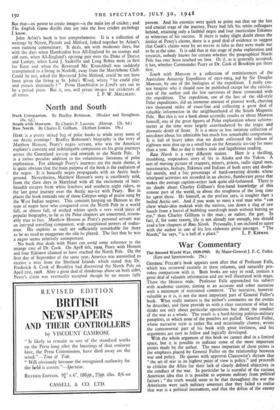North and South
HERE is a pretty mixed bag of polar books to while away some of our Arctic evenings! Bradley Robinson's biography is the story of Matthew Henson, Peary's negro servant, who was the American explorer's constant and indefatigable companion on his great journeys across the Greenland ice-cap and onwards to the North Pole. It is a rather peculiar addition to the voluminous literature of polar exploration. For although Peary's journeys are the main theme, it is quite obvious that the main purpose of the book is the exaltation of the negro. It is basically negro propaganda with an Arctic back- ground. Nevertheless, Matthew Henson's story is excellently told, from the slave days in Maryland with all the excitement of hair- breadth escapes from white lynchers and southern night riders, to the last great journey over the Arctic sea-ice with Peary. But in places the book reminds one of those Calypso songs of praise sung by the West Indian negroes. This constant harping on Henson as the type of negro hero who conquered even the North Pole in a world full, or almost full, of wicked whites spoils a very vivid piece of popular biography, as far as the Polar chapters are concerned, reason- ably true to fact. Matthew Henson as Peary's personal servant was an intrepid travelling companion, with exceptional powers of endur- ance. His exploits as such are sufficiently remarkable for there to be no need to exaggerate the role he played. The fact that he was a negro seems relatively unimportant.
No book that deals with Peary can avoid some reference to the strange case of Dr. Cook. On April 6th, 1909, Peary with Henson and four Eskimos claimed to have reached the North Pole. On the first day of September of the same year, America was astonished to receive a wire from the Shetland Islands which stated that Dr. Frederick A. Cook of Brooklyn had discovered the North Pole on April 21st, 1908. After a great deal of slanderous abuse on both sides, Peary's claim was eventually accepted though by no means fully proven. And his enemies were quick to point out that on the last and crucial stage of the journey, Peary had left his white colleagues behind, retaining only a faithful negro and four inarticulate Eskimos as witnesses of his success. If there is today slight doubt about the justice of Peary's claims, there is a good deal of evidence to suggest that Cook's claims were by no means as false as they were made out to be at the time. It is odd that at this stage of polar exploration and research, nobody knows for certain whether the geographical North Pole has ever been reached on foot. Or if, as is generally accepted, it has, whether Commander Peary or Dr. Cook of Brooklyn got there first.
South with Mawson is a collection of reminiscences of the Australian Antarctic Expedition of 1911-1914, led by Sir Douglas Mawson, by one of the biologists of the expedition. I really can- not imagine why it should now be published except for the satisfac- tion of the author and the few survivors of those connected with the expedition. The expedition, one of the last of the old-style Polar expeditions, did an immense amount of pioneer work, charting two thousand miles of coast-line and collecting a great deal of valuable information in the neighbourhood of the South Magnetic Pole. But this is not a book about scientific results or about Mawson himself, one of the great figures of Polar exploration whose achieve- ments at the time were largely overshadowed by the tragic and dramatic death of Scott. It is a more or less intimate collection of anecdotes about his admirable but much less remarkable companions. It is full of heavy jokes that no doubt enlivened the tedium of eighteen men shut up in a small but on the Antarctic ice-cap for more than a year. But to day it makes stale and lugubrious reading.
Raw North is a very different matter. Here is a thrilling, throbbing, stupendous story of life in Alaska and the Yukon. A sort of moving picture of trappers, miners, priests, radio signal men, missionaries, bishops, Eskimos and Indians of both sexes and doubt- ful morals, and a fair percentage of hard-swearing drunks whose whirlpool activities are recorded in an electric, flamboyant prose that makes the average caption-writer look quite old-fashioned. There is no doubt about Charley Gillham's first-hand knowledge of this remote part of the world, or about the toughness of the long time he spent there. He himself, as the preface says, is tougher than a boiled Arctic owl. And if you want to meet a real man who " can chew whale-skin mukluk with the natives, can down a slug of raw hooch from a barrel of bubbling sourdough mash without batting an eye," then Charley Gillham is the man ; or rather, the guy. In fact, if, for some reason, life is not already raw enough, you should read a few chapters of Raw North. Personally, I am inclined to agree with the author in one of his less elaborate prose passages. " The
North," he says, " is a hell of a place." L. P. KIRWAN.


































 Previous page
Previous page